Location: Dunlop Lake, Algoma
Date: Early July, 2023
Duration: 3 days
Day 1: Dunlop to Upper Mace
To get an early start Saturday morning, I packed up the truck and drove 5.5 hours to Elliot Lake Friday evening. I opted to sleep in the back of the truck again, waking up early to drive the rest of the way to the access point Saturday morning.
Dunlop is a gorgeous large lake. It’s mostly long and narrow, so it doesn’t feel as big as it is. It’s also fairly sheltered from high winds, so not as treacherous to paddle as other similar sized lakes. Not that winds would affect me much on my first day anyway: the water was completely calm as I set off from the Dunlop Lake access point.
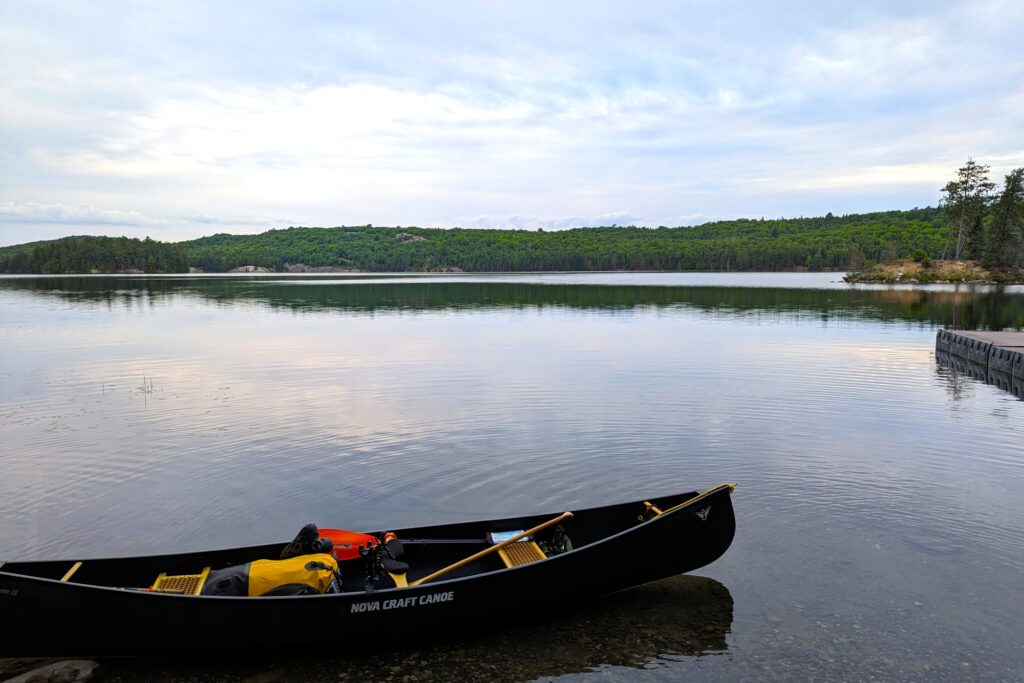
Taking away somewhat from the beauty of this lake was its south shore, which was completely lined with cottages. I imagine during the afternoon, this lake would be teeming with motor boats. The north shore however was almost completely empty, with rolling hills and that wild Canadian shield look that the north is known for.
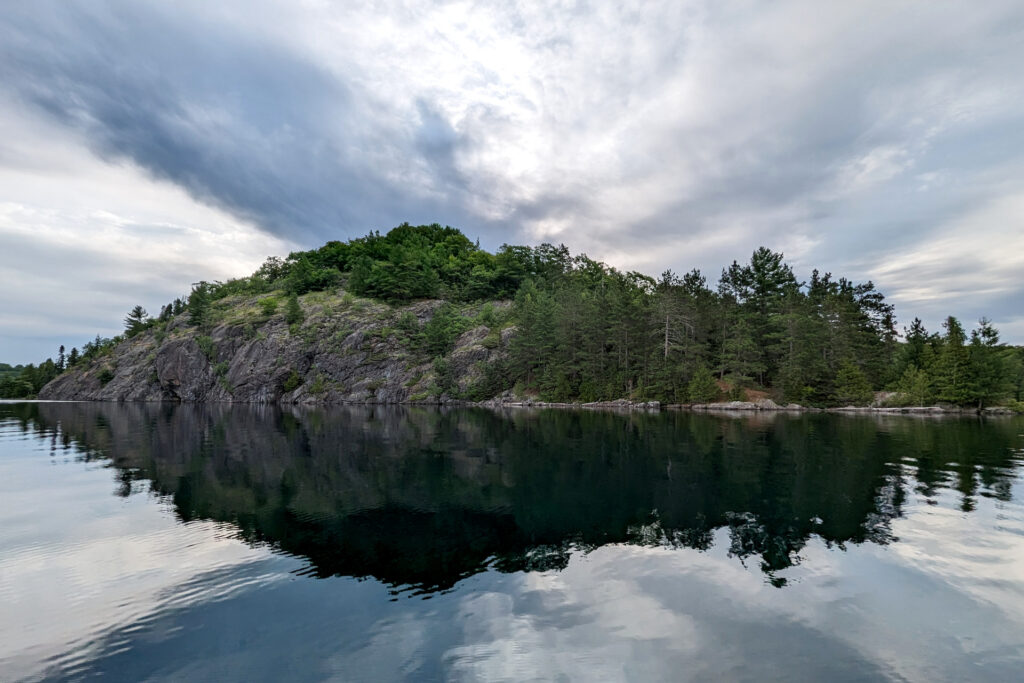
The paddle across Dunlop was fairly quick and uneventful. It took about 50 minutes while trolling fairly slowly to reach the first portage into Ten Mile Lake.
Ten Mile Lake was a nice surprise. It’s another very large lake, but a bit more open than Dunlop. It’s also extremely deep – reaching depths of almost 400 feet in spots. Its waters were a beautiful aquamarine color and were extraordinarily clear compared to the rest of the lakes on this route. You could see down what seemed like at least 40 feet. It’s a stark contrast from Dunlop, as there are no homes on this lake, other than one lodge at the far northwest corner, and a handful of very small hunt camps.
I again slowly trolled across this lake and managed to get a single small lake trout along a rock cliff.
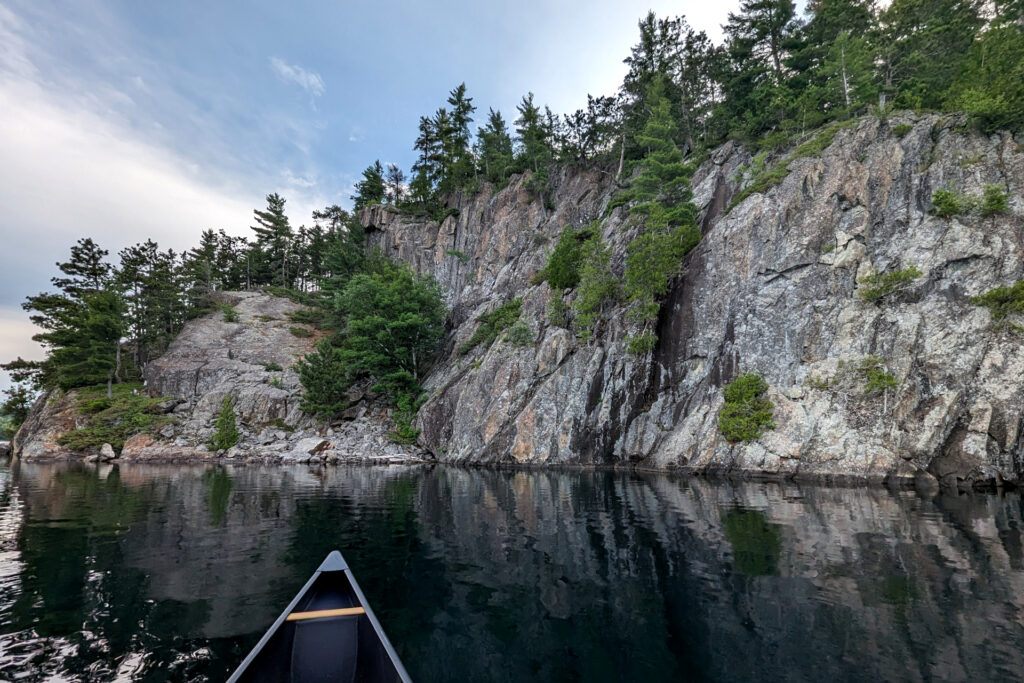
While approaching the north shore of the lake, I could hear the faint sound of rushing water. On closer inspection, there was a little stream that was tumbling down a series of small waterfalls and rocks, eventually trickling into Ten Mile Lake. Its waters dispersed quite a lot as it reached the lake and it was barely visible until you were on land.
I got out of the canoe to look around for a bit. The elevation changed quite a bit here as the stream tumbled over the landscape. I believe there’s also another portage close to here, leading to some lakes further north. I imagine that portage, though fairly short, would be quite challenging due to the elevation changes.
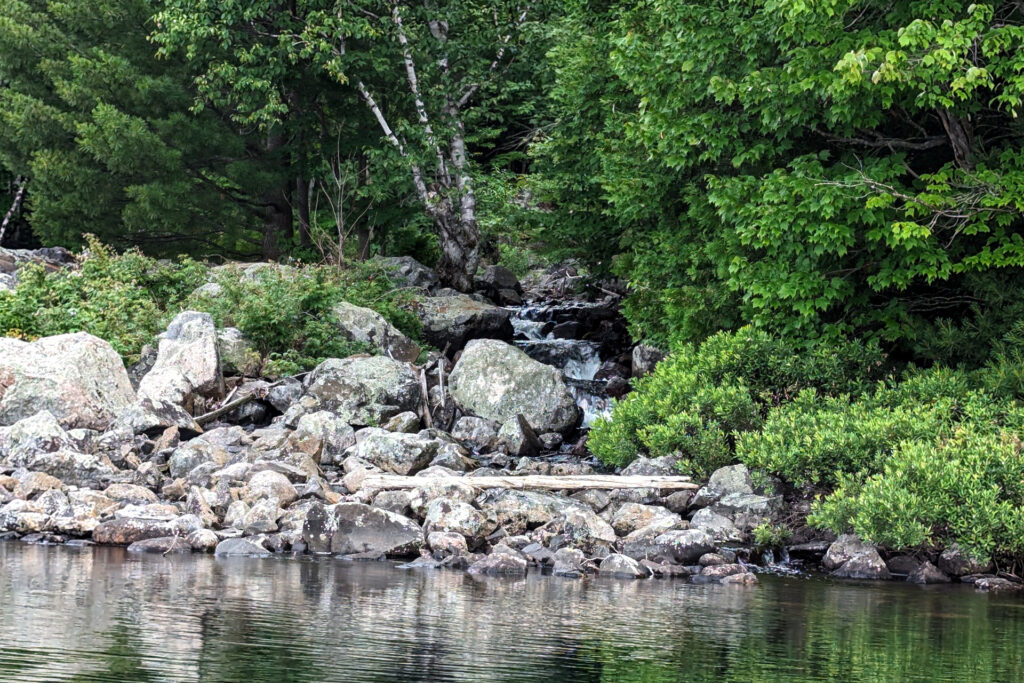
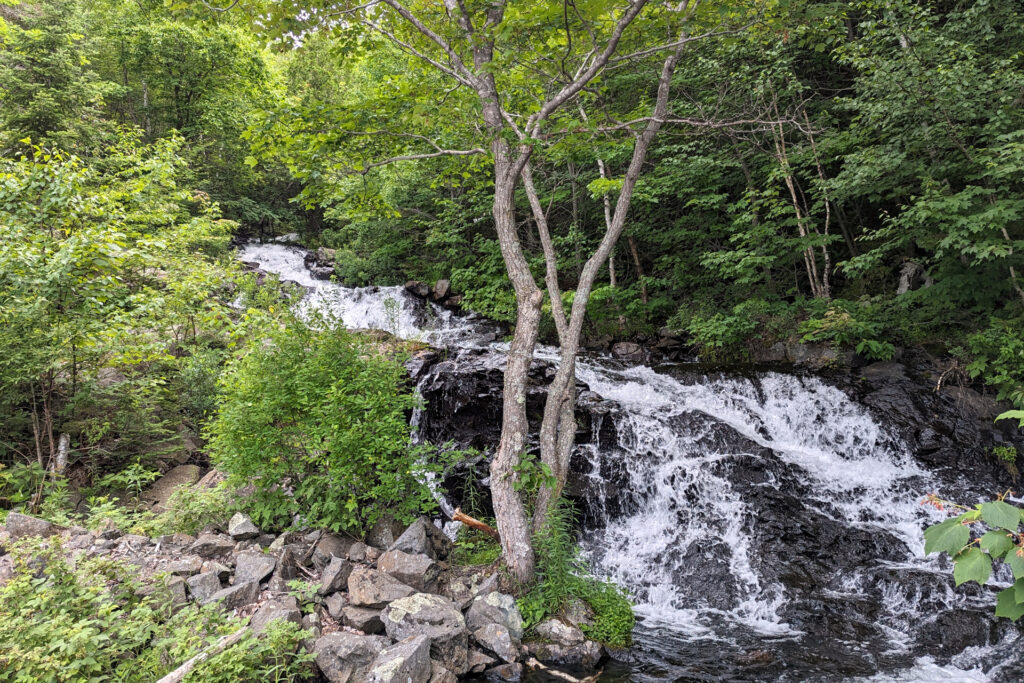
The mosquitoes were getting bad at this point and the lack of any strong wind, though nice for paddling, wasn’t helping the bug situation.
On my journey west along the north shore, I ran into the owner of the lodge on Ten Mile. We chatted for almost half an hour and he was super helpful in giving me some tips for my route. He mentioned that there was very little canoe traffic through the area recently – my guess is due to it still being fairly peak bug season (at least for the mosquitoes). In all honestly, I didn’t expect them to be nearly as bad as they were, but more on that later.
It was around 10:30 am when I reached the portage from Ten Mile into Ezma Lake. This portage (along with the one before it between Dunlop and Ten Mile) was just under half a kilometer. There was nothing particularly difficult about either of them – both were clear, though there was a bit of an incline to carry over heading into Ezma.
There are a couple decent campsites on this lake, but I wasn’t planning to stay here. I stopped to spend a bit of time fishing, focusing in the area the lodge owner had mentioned (which happened to be the very same area I had previously identified as a likely holding spot). It took just one cast here to hook another lake trout, this one slightly bigger than the first.
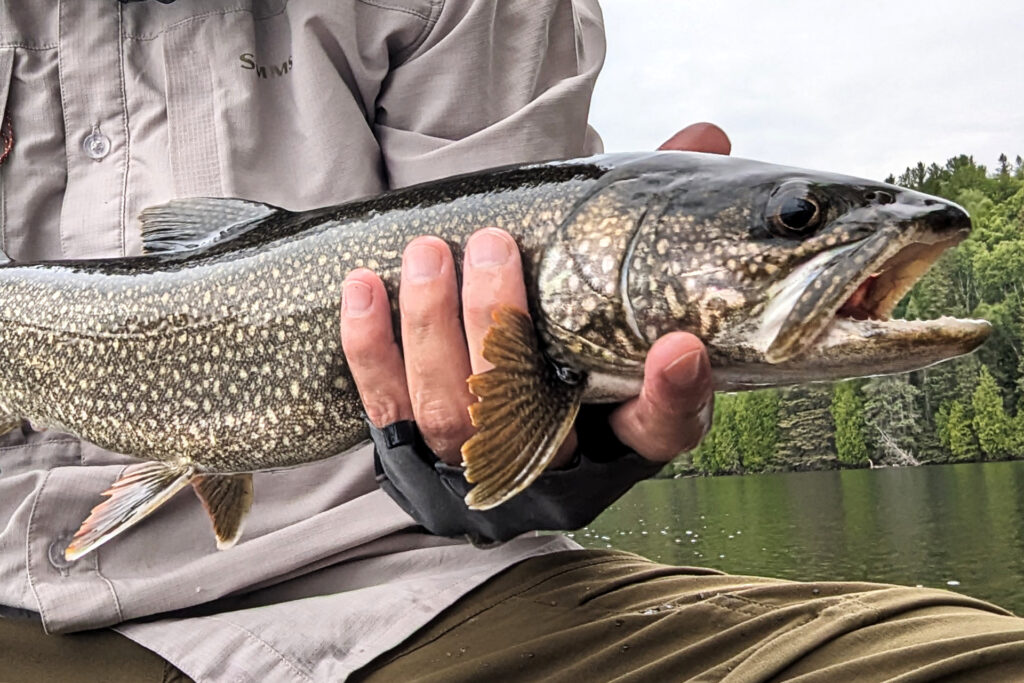
I spent a few more minutes fishing here, expecting my luck would continue. Other than one other hit that didn’t materialize, this was the only fish I’d see on Ezma.
The next portage from Ezma to Swamp Lake was shorter, at around 200m. I knew nothing of this lake, other than its unappealing name. As it turned out, it was indeed worthy of its name, as it was a shallow, mucky, lilypad infested swamp. I was in my bug net at this point, as the mosquitoes were understandably worse here.
The portage from Swamp Lake to Upper Mace was not quite where it was marked on the map I had. The lake is all jammed up at its south end and I imagine that the portage changed as a result over the years. Nevertheless, I found it and did the roughly 250m portage, putting me on Upper Mace Lake by around 1:00 pm.
The first large bay on Upper Mace is extremely shallow with lilypads, somewhat similar to the end of Swamp Lake. However, once you exit this bay, the real beauty of the lake becomes apparent. The rock on this lake takes on a pink hue and the lake is dotted with several islands – one of which would be my campsite for the next couple of nights.
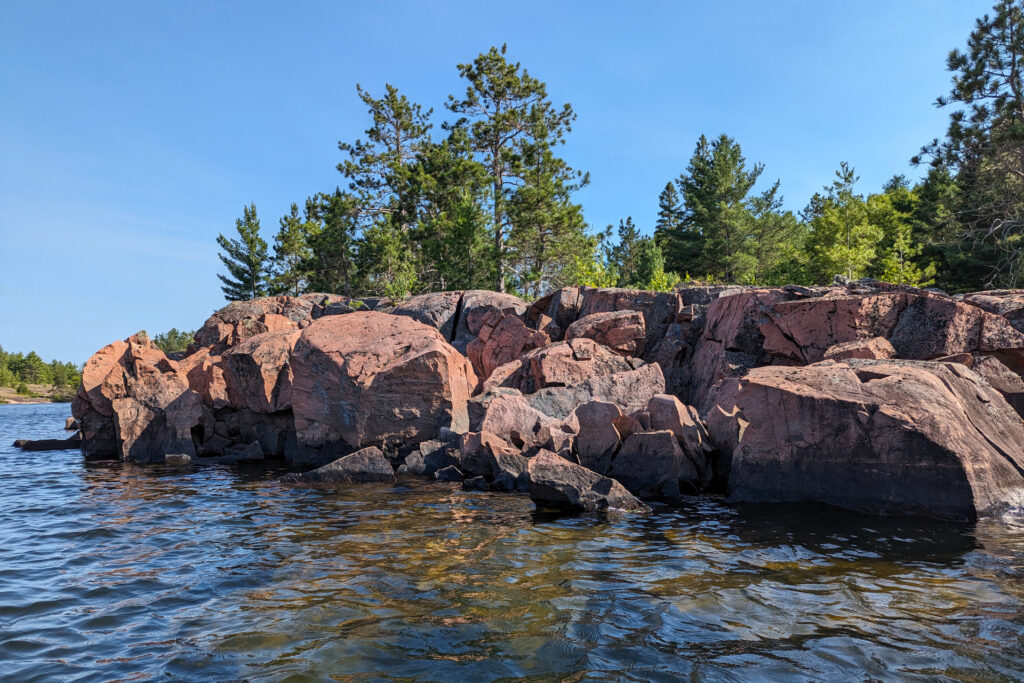
After paddling around the lake inspecting several sites, I settled on one of the larger islands, which had lots of space for hammocks, tents and a nice big rock landing at the bottom. It was around 2:30 at this point.
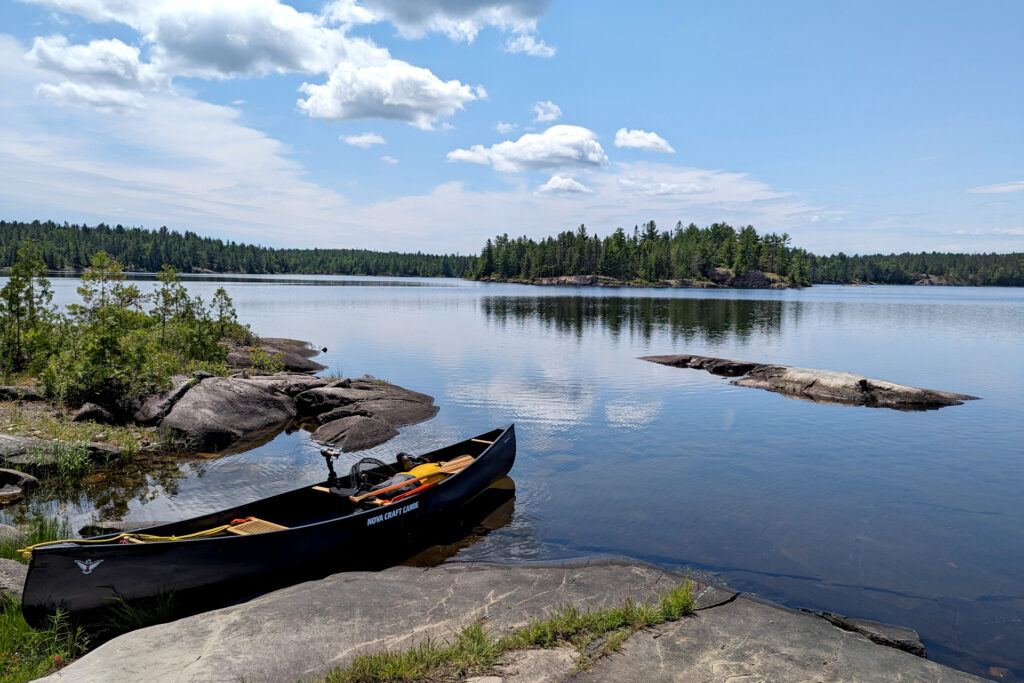
I made a late lunch and lounged around camp for a while, as I was pretty tired from the early start. Usually my trips involve full days of travel with little downtime, so it was nice to be at camp so early and have the luxury of simply relaxing for once.
At around 5:30, the weather made a turn for the worse as the winds picked up considerably and the skies turned dark. I used this as an excuse to lounge around even longer – swinging in the hammock, reading a book and sipping on whiskey.
When the weather settled down a couple hours later, I decided to head out for the last hours of sunlight and do some fishing. I was mostly trolling and scouting for spots to focus on the next day, but failed to hook into any fish. It was still an enjoyable paddle and I was treated to a nice sunset on my way back to camp.
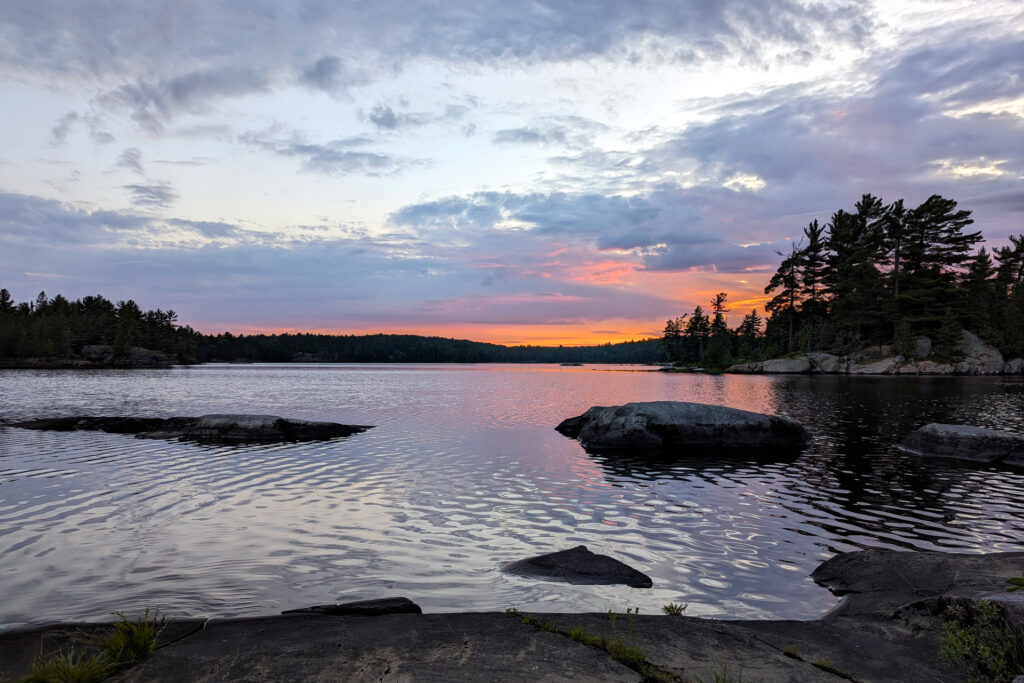
Unfortunately, due to the lack of mosquitoes while out fishing and when I got back to camp, I failed to compensate for the fact that they would be back with a vengeance at dark.
So, about half-way through leisurely making dinner, I was met with one of the worst swarms of mosquitoes I can recall. They were so thick that I couldn’t breathe without inhaling them – and of course, trying to eat dinner with a bug net around your head isn’t very practical. The only way I could attempt to not be eaten alive was to walk at a swift pace while stuffing my face with food. That’s exactly what I did and when I was finished eating, I frantically rushed to stuff all my food and other belongings back into their packs and change out of my clothes from the day (that was especially fun!).
As brutal as that was, I half wish I could have gotten it all on film. I’m pretty sure that the sight of me frantically undressing while constantly swatting mosquitoes and swearing, then sprinting half naked to my tent and literally diving into it, could have racked up quite a lot of YouTube views…
Day 2: Fishing, Exploring and Rest
I was up early, but could still hear the buzzing of mosquitoes outside and decided to stay in the tent until around 8:30 am. Thankfully, they were almost completely gone when I emerged.
Tranquility is the best word to describe morning on the lake. There wasn’t a single ripple on the water, the skies were perfectly blue and the bugs were gone.
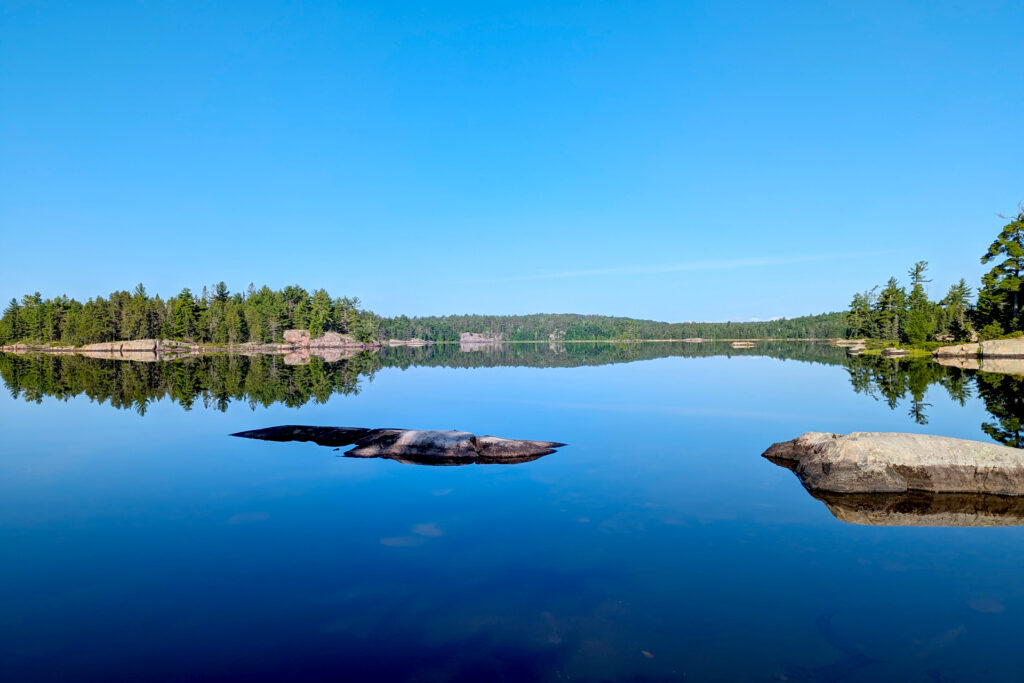
Given the conditions, I probably should have been up earlier and out fishing. This is where a fishing/travel buddy would probably come in handy, as it would give some extra motivation to get an earlier start. I do tend to be a bit slower on the first mornings of my trip, since I’m always a bit exhausted from the travel and system shock on the first day.
After enjoying breakfast and a morning coffee, I was out on the water, heading back to the spots I scoped out the night prior. I trolled some likely looking drop-offs for a while, before stopping my canoe at a very fishy looking spot and doing some casting / retrieval instead. I had a new full sink setup for this trip, so getting down was much easier than having to rely on a floating line with sink tips.
It wasn’t long until I hooked into a good fish here. It put up quite the fight and turned out to be a great looking Splake!
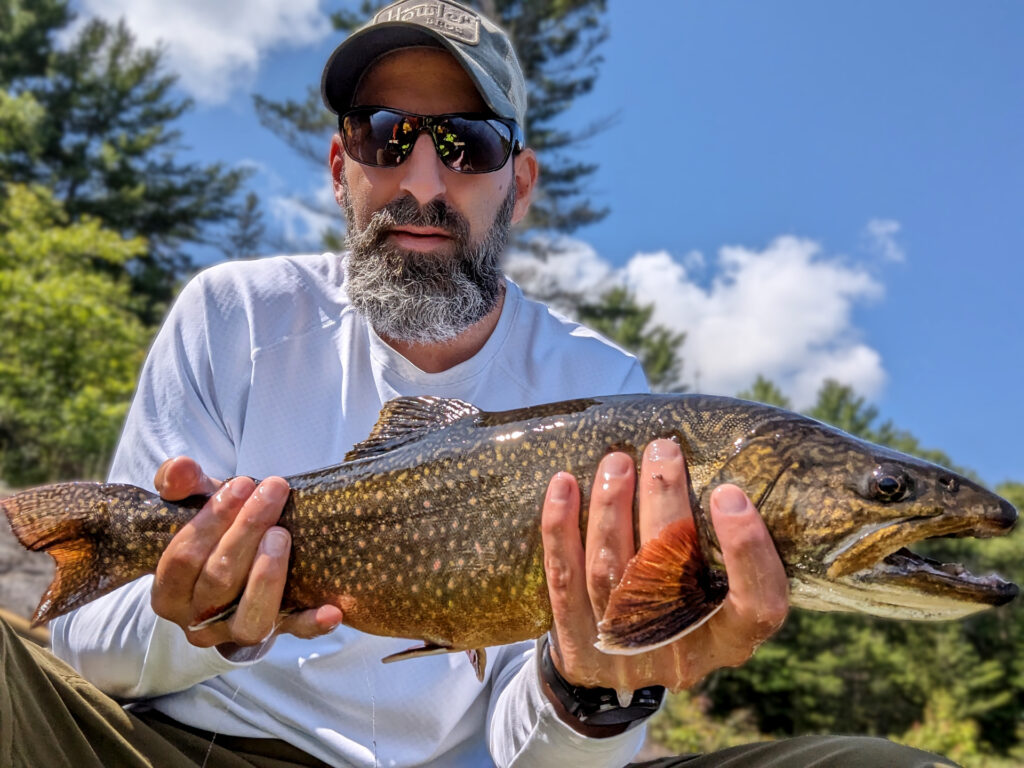
Upper Mace is stocked with them and I was hoping to get at least one this weekend. This one had a lot more brookie in it than laker, at least in my opinion.
It’s worth mentioning that, while I always tend to group most of the salmonoids I fish for as “trout”, many are actually Char: including Brook Trout, Lake Trout and Splake. Although Splake are technically capable of reproduction and occurring naturally (they are a cross between a Brook Trout and Lake Trout), in practice, they don’t really do either. They’re put into many northern Ontario lakes purely as a sport fish. That said, they grow fast and can get quite large due to their Lake Trout genes, yet they carry many characteristics of a Brook Trout. An older, larger Splake that has spent a good number of years in a lake, is quite an exciting fish to target and catch.
There is also a lot less reason to feel guilty about keeping a Splake, since they aren’t going to end up contributing to spawning. However, since they can live fairly long and continue to contribute to the quality of a fishery, I still tend to release them unless I’m specifically out fishing for a meal (rare).
I had a couple more follows after that fish, before heading out for a bit more trolling and exploring on my way back to camp for lunch. As a repeat of the day before, the winds picked up considerably again, keeping me camp-bound for the next few hours, before once again heading out for some early evening fishing.
This time I decided to head south and portage into a small lake (Lake #5), that there doesn’t seem to be much info on. Since it’s connected to both Upper Mace and the Lake below it, I figured it must support a healthy population of fish – possibly even Brook Trout.
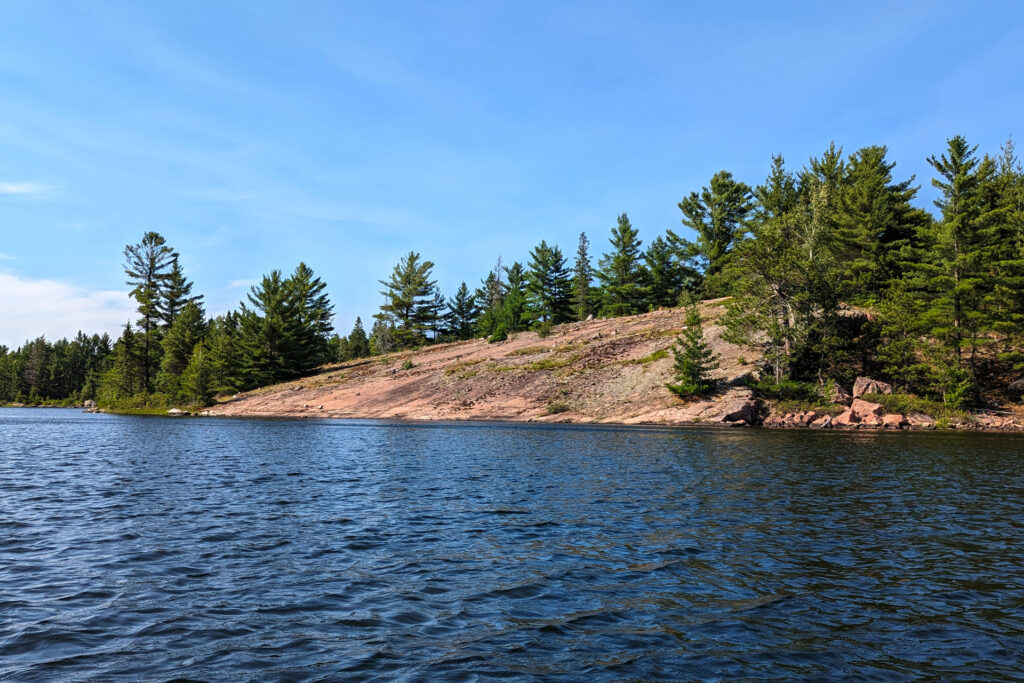
The portage between the two lakes is pretty awesome. It’s essentially a natural portage along a huge granite outcropping, similar to the one picture above. These spots just have the look of a perfect place to spot a Bear, though I didn’t see any (at least, not today).
Along the portage is a very tiny picturesque stream (if you can call it that), which meanders along a large rock cliff. I wonder what this would look like in the spring in high water. It was super cool seeing it slide along the granite floor and curve along the cliffside.
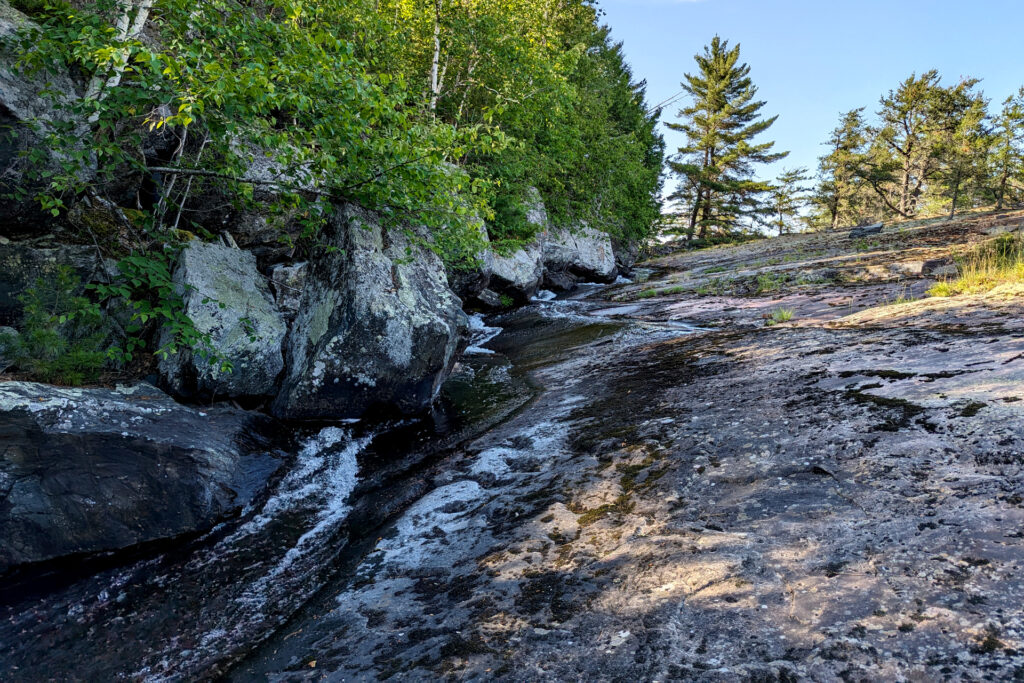
Lake #5 was a nice little lake, without what seemed like enough depth to potentially hold some trout (there are no depth charts available for this lake). But, try as I did, I didn’t see or hook into anything during the couple of hours I spent fishing it.
I headed back towards Upper Mace and my campsite at around 7:30 pm. The winds were still a bit high, but there was enough shelter along shorelines and islands to not have it pose much of a problem. I had a couple more hits while trolling back, but didn’t keep any of them on the line.
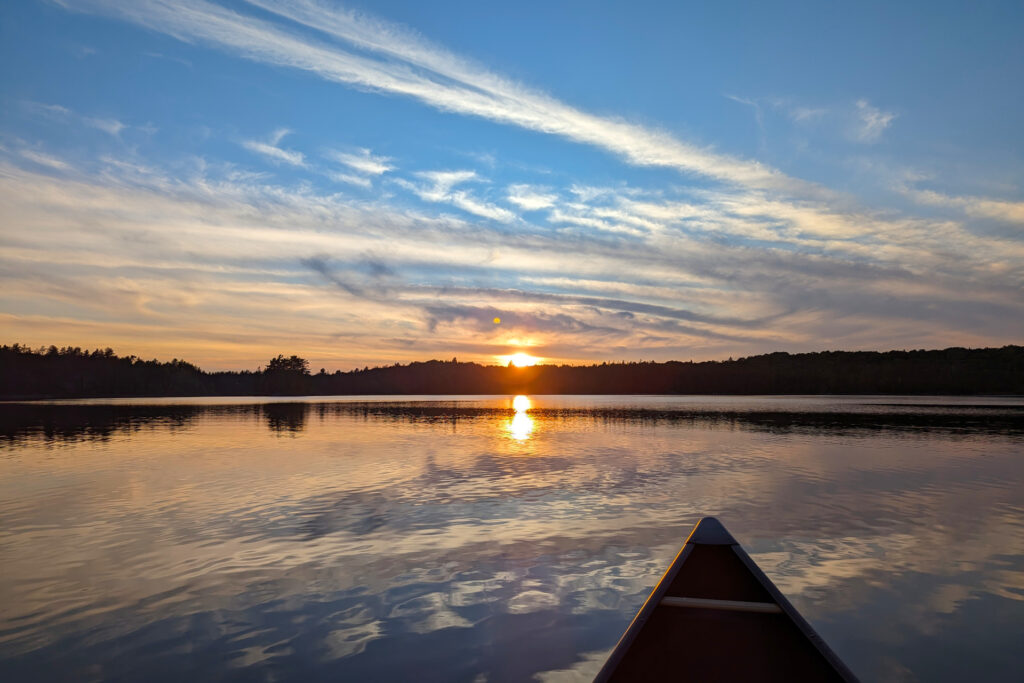
Back at camp, I was treated to another gorgeous sunset. Although the front of my campsite was well protected from the wind, there was a good breeze blowing through the rest of it. In my lack of judgement, yet again, I incorrectly assume that this breeze would somehow lend itself to reduce the severity of the mosquitoes this time around. Was I ever wrong…
What ensued was basically a repeat of the night prior, with me frantically rushing to finish dinner and packing loose items at camp before rushing into the tent for shelter. Having the option of a campfire would certainly have helped with these devilish bugs, but even then, I don’t think it would be nearly enough. From what I’ve heard from others, this year has just been an especially bad one for bugs.
At around 11:30 pm, as I was drifting off to sleep, I heard something of considerable size get out of the water on my island, near the front of my campsite. That was a bit odd and concerning, given that my island was fairly well separated from the rest of the islands and mainland. I heard it walk around on land a bit and it prompted me to get my shoes on and grab my headlamp and bear spray. Just as I was building up the courage to get out of the tent and go check it out, I stopped hearing it. The thought of going outside with the mosquitoes was less than inviting, so I lied back down quietly and listened, but didn’t end up hearing it again. In my mind, I thought, perhaps it was just a beaver or smaller animal that simply sounded larger than it was due to the dead quiet of night. I’ll never know.
Day 3: Paddling and Portaging Out
I awoke much earlier today, at 5:15 am. Winds were supposed to pick up considerably and I had a pretty long day of travel to make it back to my truck. I wasn’t sure what the winds would have in store for me on some of the larger lakes (including Dunlop), so wanted to finish most of the paddling as early as possible.
After taking down camp, making a coffee and eating a cold breakfast, I was on the water at 7:00 am. Interestingly, as I was pulling up to the portage between Upper Mace Lake and Lake #5, at the very same spot that I thought to myself yesterday “this looks like the perfect spot to see a bear”, I did in fact see a bear. It was a mid sized black bear, about 40 feet up on the granite clearing. It didn’t see me at first, so I stopped paddling a few feet from the portage. I didn’t think I made any noise, but it turned, looked at me briefly and then bolted into the bush. Unfortunately, that meant I couldn’t snap a picture – but fortunately, it meant that the bear did the right thing (rather than hang around and become interested in me).
The next lake, Lilypad Lake, also depicted images of of shallow swampy water, somewhat similar to how “Swamp Lake” did – albeit slightly more appealing sounding. The portage between Lake #5 and Lilypad Lake was actually quite nice though, with another small stream with some tiny falls cascading along the base of the granite.
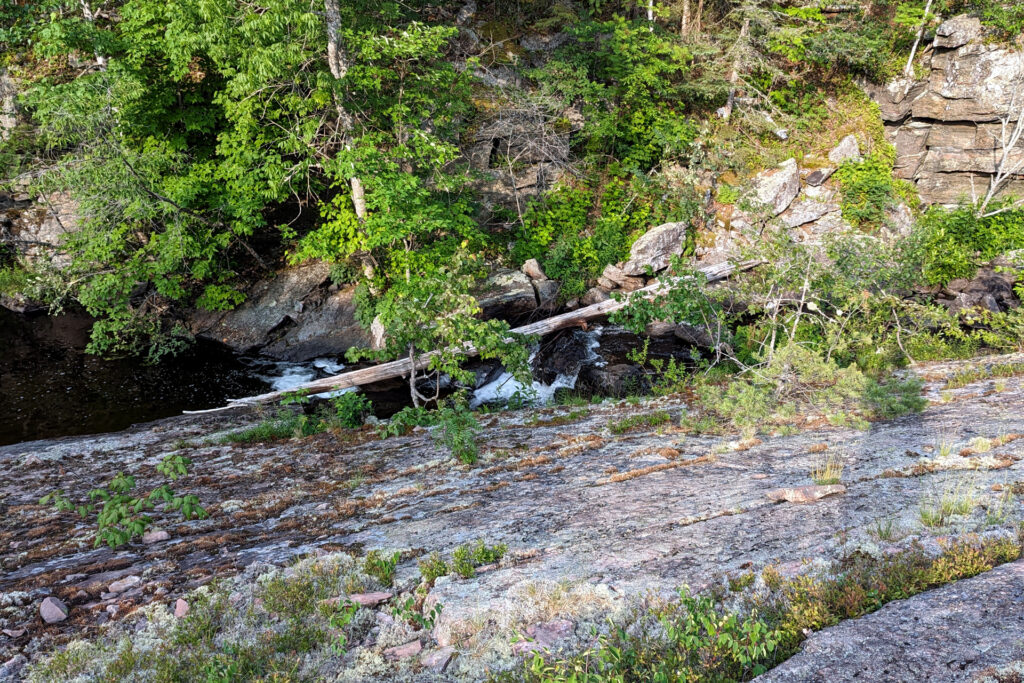
Lilypad Lake itself however, was once again just what I imagined from its name. In fact, in my trip log, I specifically wrote that it was “a brutal, mosquito infested sludge factory”. To be fair, I think that was more the case at the start of the lake – and things improved slightly the further south I travelled. That said, it was essentially rowing through lilypads for the entire (fairly long) paddle.
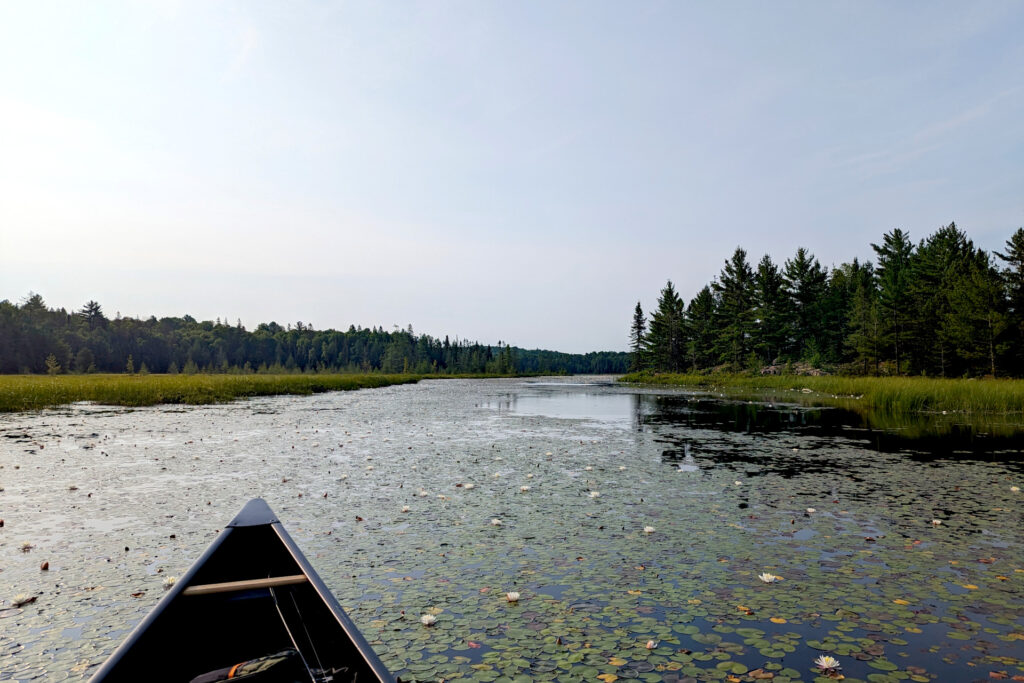
At the lower end of the lake, there’s a huge beaver dam that requires lifting or dragging over to access Lower Mace Lake. I heard there may also be a portage around it, but I’d much prefer to drag over a beaver dam, than unload all my gear, carry it and the canoe around, then load it all again.
As an aside, I’ve been pretty impressed with the durability of my canoe (Nova Craft, Blue Steel), considering its 45lb weight. It’s no TuffStuff and perhaps I shouldn’t be so eager to drag it over dams, sticks and occasionally small rocks/stones. But it seems to hold up well to this type of abuse, outside of the expected minor surface scratches. I’ve even dropped it (accidentally) a couple times on portages, where it’s landed squarely on some big rocks, without taking any visible damage.
As it turned out, after dragging over the dam (which had a roughly 6 foot drop to the water on the other side), there was a small creek to navigate, which required mostly wading and a bit more dragging. It was about 10:30 am after the 100-200m of creek wading.
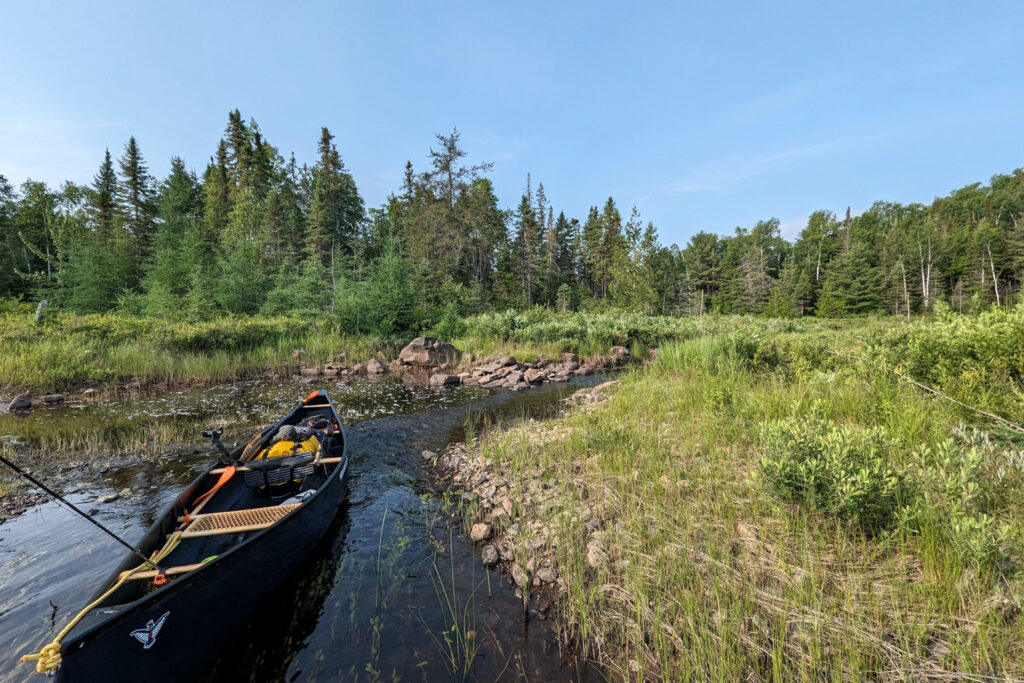
Lower Mace was nice, but somewhat featureless in comparison to Upper Mace. There’s one large island on it, but otherwise it’s mostly wide open. One missed hit on the rod while trolling through this lake was all I got out of it, though I’m sure there are plenty of fish if you wanted to spend some time here.
The portage from Lower Mace to Claim Lake was about 600m and I don’t recall anything specific about it, other than the mosquitoes. Claim Lake itself was similar to Lower Mace, but smaller. There are supposed to be both Splake and Brookies in it, but I have a feeling it gets a good amount of fishing pressure given its proximity to Dunlop Lake. I fished it fairly thoroughly but didn’t get anything. Keep in mind, my fishing through these lakes was in early July and mid-day: not exactly prime time. I’m sure that had more to do with my success than the lakes themselves.
The final portage of the trip was a 1360m one, between Claim Lake and Dunlop Lake. At the beginning of it, what seemed like a small bird flew right in front of my face and landed on the ground in front of me. It turned out to be a large moth – an Imperial Moth if my identification was correct. It was definitely big!
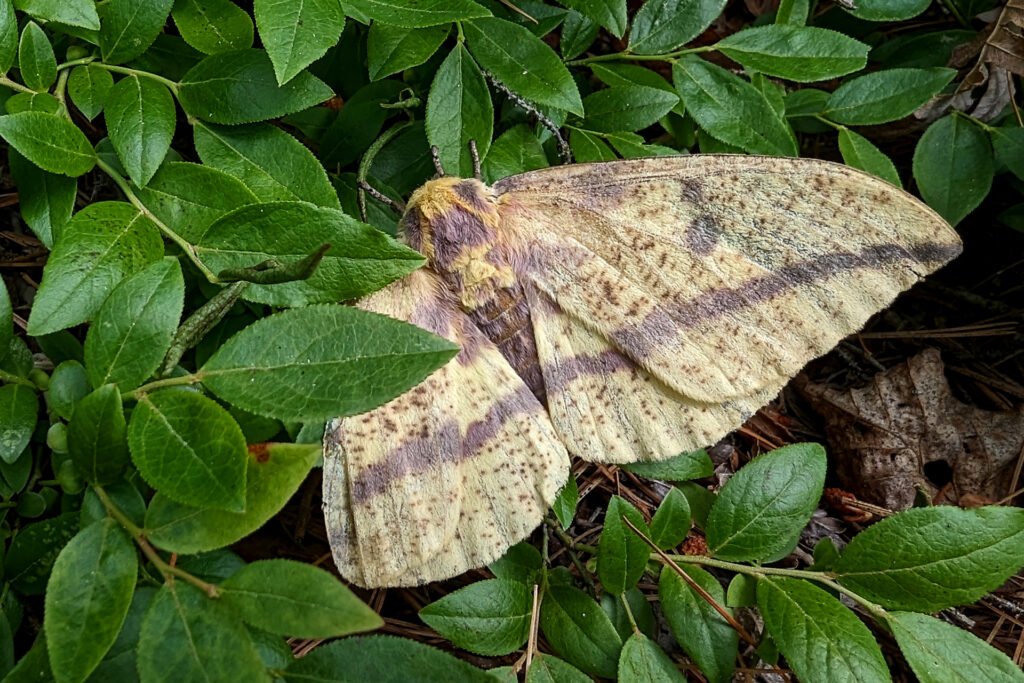
This portage felt LONG, which is somewhat strange considering I’m quite used to the portages in Algonquin, which probably average close to that in length (some being up to 4 times longer!). The portage was fairly clear and wide though, so I have a feeling it was a combination of the heat and thick mosquitoes that made this one seem tougher than it was. That said, it only took about 1 hour and 15 minutes (double carry).
It was 1:15 pm when I paddled away from the portage into Dunlop Lake for the last leg of my trip. The wind was coming from the south, meaning that I was fairly sheltered from it by paddling the south shore. I lost a couple more fish trolling Dunlop. Clearly I need to get better at reacting and setting the hook (and getting my rod out of the holder), given the number of fish I lost trolling on this trip. Barbless hooks certainly don’t help in this regard, but they’re worth it for the improved survivability rate of released fish.
The remaining paddle was uneventful, but enjoyable, lasting a total of about 1.5 hours. Overall an enjoyable trip that felt longer than 3 days – and it’s one I’ll likely do again, perhaps in the shoulder seasons, when the bugs aren’t as bad and the fishing somewhat better.
